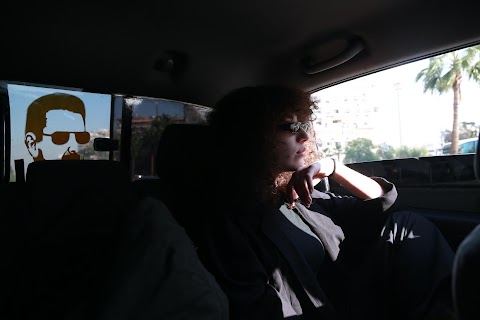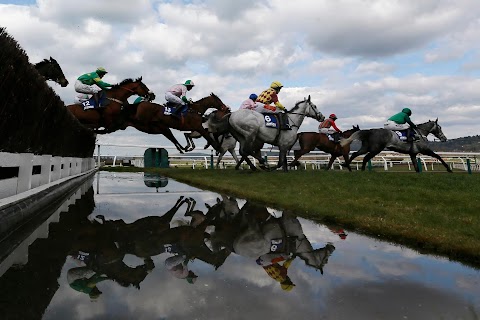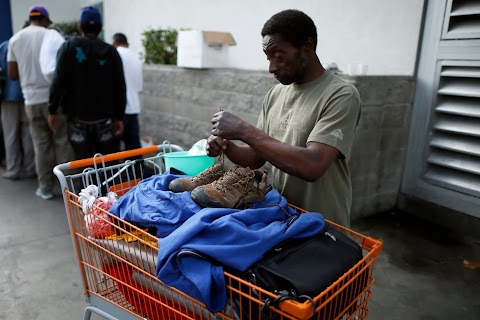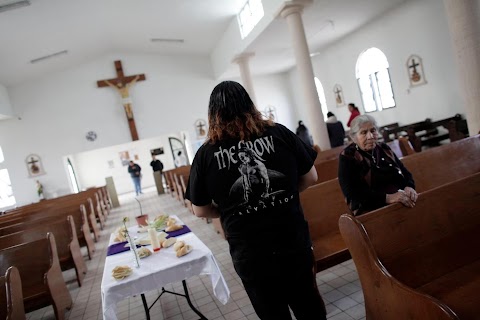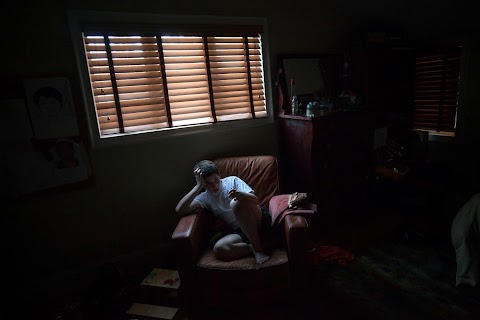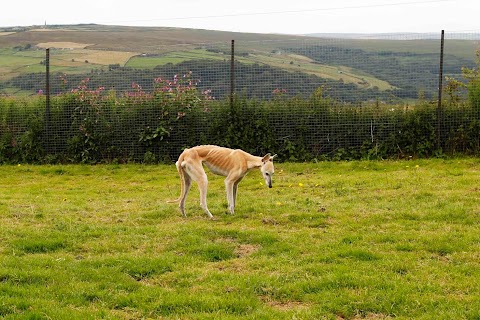
Gone to the dogs
 Chris Helgren
Chris Helgren
A bundle of skin and bones, Alice was found infested with fleas, wandering a busy road outside the northern English city of Doncaster. The six-year-old greyhound was bred to race, but she was not fast enough. She was used for hare coursing but failed at that too.
So Alice was abandoned, just like many unsuccessful greyhounds in Britain's multi-million dollar industry that is in decline as the popularity of dog racing wanes.
Slideshow

A greyhound typically starts racing at the age of around 18 months and stops in its fourth year, unless its career is cut short earlier by an injury. The dogs naturally live to be about 13.

The sport the dogs take part in was once highly popular, with 80 licensed greyhound tracks in Britain governed by the self-regulating Greyhound Board of Great Britain (GBGB).

Now dog racing is in decline: the number of greyhound tracks like this one in Wimbledon has fallen to about 26, although there are some unregulated racetracks too.

The number of people who come to see greyhound races has slumped and so has the amount of money that is bet on them.

Greyhound co-owner Rebecca Taylor embraces Taylors Sky after winning the 480 metres Derby Final, the biggest race of England's greyhound season. In 1947, 60,000 spectators were recorded at the Derby at White City. In 2011 the Derby was held at Wimbledon Stadium and attendance was just 2,423.

Dogs that are not successful or too old for the industry can be abandoned, like Alice, who was found wandering the busy Doncaster Road in the north of England. She was picked up by a volunteer and ended up here, at the Tia Greyhound and Lurcher Rescue centre in West Yorkshire.

There are many greyhounds who need homes. The British government commissioned an inquiry into the industry in 2007, which found that an estimated 35,000 dogs were bred annually for racing but only 8,000 a year made the grade and those who did only raced until about the age of four. The partly industry-funded Retired Greyhound Trust says its 72 adoption branches find homes for roughly half the dogs that retire every year.

The GBGB says it has its own system in place to track the animals and to report strays. It maintains that greyhounds are not being abandoned in large numbers. However, unwanted dogs like Alice continue to fill the kennels of the Tia Greyhound and Lurcher Rescue centre.

Some dogs in need of a home are given help at Wimbledon Greyhound Welfare, an independent retirement kennel in Surrey.

For lucky dogs there is a rich life to be had life after racing. Paula Boswell guides Gabby, Bobby and Connie during an annual trip to the beach with owners and volunteers of retired racing greyhounds in West Sussex.

Deedee, a six-year-old rescued racing greyhound, was given a home by actress and activist Annette Crosbie. She lies next to her owner in their home in southwest London.
Video
Wendy Jones, Alice’s new owner talks about her experience with the greyhound.
"Personally, I’m not a dog person… so my motives behind pursuing this story were not sentimental. I merely sensed a story of injustice."
I met Alice at a rescue centre in West Yorkshire. She was skin and bones, flea-ridden, and half the weight of the dog she should have been.
Alice was a greyhound bred for racing. She was picked up wandering the busy Doncaster Road, the victim of an uncaring owner who had dumped her rather than continue giving her food. She was brought to Tia Greyhound and Lurcher Rescue centre, an independent sanctuary situated on the edge of a moor near Hebden Bridge, West Yorkshire.
The Tia centre was created to house dogs that had either been abandoned or whose owners or trainers could not find space at regular welfare kennels.
There are other organisations that help British greyhounds too. The Retired Greyhound Trust, a charity partly funded by the greyhound industry, is doing an admirable job in housing and arranging for homes for about 4,000 dogs per year through their 72 branches. But their space is limited to about 800 kennels.
Debra Rothery, who runs the Tia center, said that at any given time they house 80 dogs that would “otherwise be dead”. The animals coming into her care are from the region surrounding the sanctuary, where there are six regulated and non-regulated racetracks.
She said that about 50 percent of her greyhounds were abandoned, the remainder brought in by owners and trainers. Rothery said that the operating costs of Tia, which run at £1000 per day, are met by donations.
Personally, I’m not a dog person. I’ve always had cats, so my motives behind pursuing this story were not sentimental. I merely sensed a story of injustice, one of the classic themes for reportage.
Former working dogs that should be enjoying their retirement are being cast aside or killed because elements of the declining racing industry turn a blind eye to the problem.
The Greyhound Board of Great Britain (GBGB) does not believe the dogs registered with them are being set loose on the streets in large numbers, and have a set of standards that they maintain are vigorously enforced by their welfare officers who report breaches to prosecuting authorities.
The GBGB says that the greyhound is now the most protected of all canine breeds after the introduction of the 2010 Racing Greyhounds Regulations. However, despite the tough talk, Tia’s kennels continue to fill with unwanted animals.
My photo project with the greyhounds started originally from a simple exercise in environmental portraits at Wimbledon Stadium for my MA course in photojournalism and documentary photography at London College of Communication.
When I lived in London in the 1990s, I visited the now-derelict Walthamstow racetrack on several occasions. A friend of mine introduced me to the place, a grand palace of the sport, and I felt an affinity with the atmosphere. Later, I brought friends of mine to experience racing nights there and witnessed what appeared to be real Londoners enjoying themselves.
Central London seemed to me at the time to be filled with transients, both foreigners like myself and office staff who had migrated from the rest of the United Kingdom. Real Londoners seemed to have kept themselves segregated and went off to live their lives apart from us. But here at the track in east London, this was where to find them, their stock was undiluted.
Trainers and owners are now leaving the sport in large numbers because their margins are so low they cannot continue. Blaming track closures in Reading, Walthamstow, Hull, Portsmouth, Coventry and Oxford, the GBGB say that the number of professional trainers has fallen by 129 in the last five years, from 510 in 2008 to 381 today.
Those that remain must cut costs wherever possible. The vast majority will not mistreat their animals but a few, when faced with the inability to place their retiring or injured dogs with a limited number of welfare kennels, have decided to give them away to the first person they find, let them loose, put them down or sell them to research labs rather than continue housing and feeding them.
Campaigners are asking for more transparency in the record keeping of racing greyhounds, including where they are from birth to death, but opposition to this comes from people saying data protection laws would be breached.
The GBGB maintains a database and say that they share their microchip information with “responsible re-homing organisations” and dog wardens.
However, what happens once a dog has been passed on from its original registered owner? Surely there’s a way around it.

